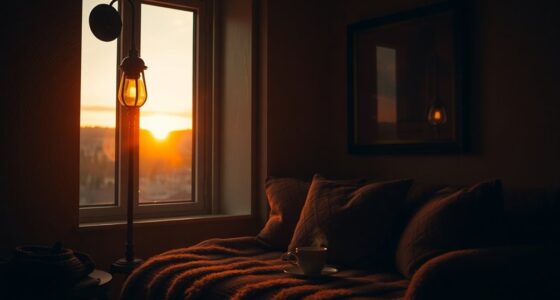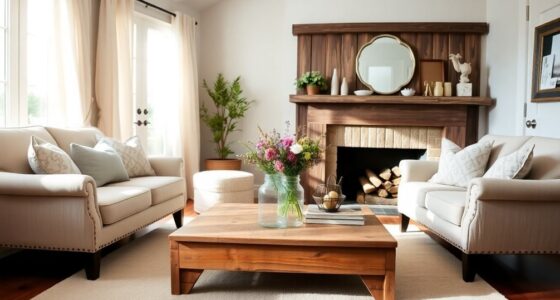Designing a space you'll love starts with understanding your needs and preferences. Focus on space planning to ensure functionality, and choose a color palette that reflects your emotions and style. Incorporate varied lighting techniques for atmosphere, like layered ambient and accent lights. Select furniture that's both functional and stylish, ensuring it fits well within your layout. Don't forget to add decorative elements like artwork and textures for personality. Embracing technology can elevate your design too, making it more enjoyable. Keep exploring these tips to create a space that's uniquely yours!
Key Takeaways
- Assess your needs and preferences to create a personalized design that reflects your lifestyle and tastes.
- Choose a harmonious color palette that evokes the desired emotions and aligns with cultural significance.
- Implement layered lighting techniques to create various atmospheres, enhancing both functionality and ambiance.
- Select functional furniture that balances scale, proportion, and accessibility while incorporating eco-friendly materials.
- Enhance your space with decorative elements like artwork, mirrors, and varied textures for depth and personality.
Space Planning Essentials

When you embark on designing a space, understanding your client's requirements and preferences is crucial.
Start by identifying their needs and jotting down their preferences. Look for overlaps between what they want and what design principles dictate. Incorporating natural elements like plants can enhance the overall aesthetic and promote a calming atmosphere.
Prioritize these needs based on importance and urgency to create a comprehensive client brief that steers your design process. Proper space planning minimizes common mistakes in layout and functionality, ensuring that the design aligns with the intended use of the space.
Establishing a feedback loop ensures that you're meeting their expectations throughout the project. This approach not only clarifies your direction but also builds trust.
Choosing Your Color Palette
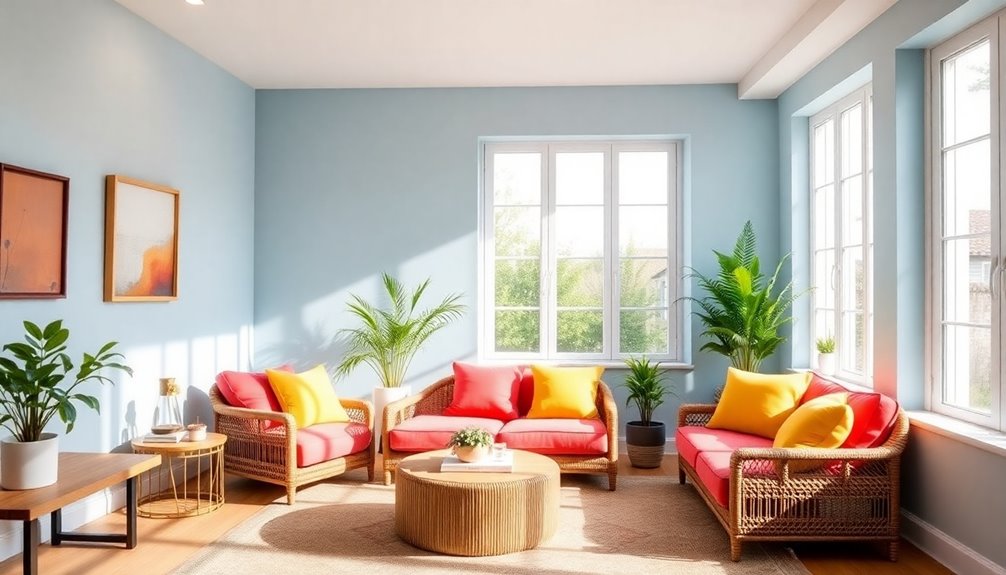
Once you've established a solid understanding of your client's requirements, the next step is choosing a color palette that aligns with their vision.
Start by considering color psychology; different colors evoke emotions and can influence the mood of a space. For example, blue promotes calmness, while red sparks energy. Think about cultural significance and personal preferences, as they can greatly impact choices. Additionally, consider how lighting design can alter the perception of colors throughout the day.
Next, apply color harmony principles. You might select a monochromatic scheme for cohesion or a complementary palette for contrast. Utilizing a topic web can help facilitate connections between these color choices and the overall design theme.
Don't forget the practical aspects: ensure colors maintain sufficient contrast for visual appeal and consistency throughout the space.
Lastly, stay updated on color trends to keep the design fresh and relevant. This thoughtful approach ensures your client's space reflects their personality and needs.
Lighting Techniques for Atmosphere
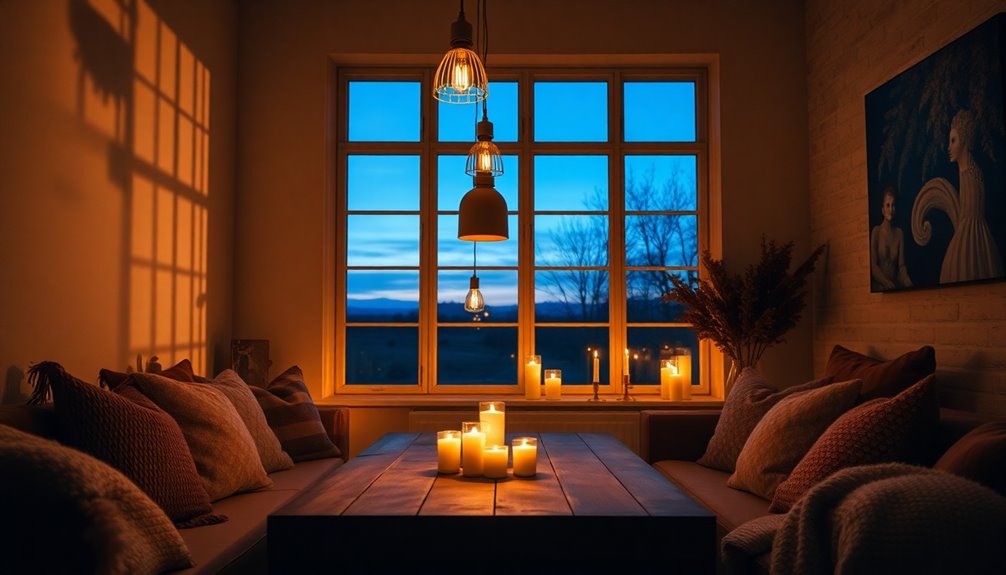
Creating the right atmosphere in a space hinges on effective lighting techniques. Start with layered lighting: ambient light sets a warm tone, task lighting focuses on areas for activities, and accent lighting draws attention to unique features.
Consider using dimmable options to adjust brightness based on your mood.
Next, pay attention to color temperature. Warm whites create a cozy environment, while cool whites energize kitchens. For workspaces, daylight tones are stimulating.
Placement matters too; use ceiling fixtures for overall illumination and table or floor lamps for versatility.
Control your lighting with switches, dimmers, or smart home systems to enhance convenience.
Finally, opt for energy-efficient LED bulbs to save on electricity while maintaining a beautiful ambiance. Additionally, consider how waterproofing treatments can protect your space's fabric elements from moisture damage, especially if your design includes outdoor features.
Selecting Functional Furniture
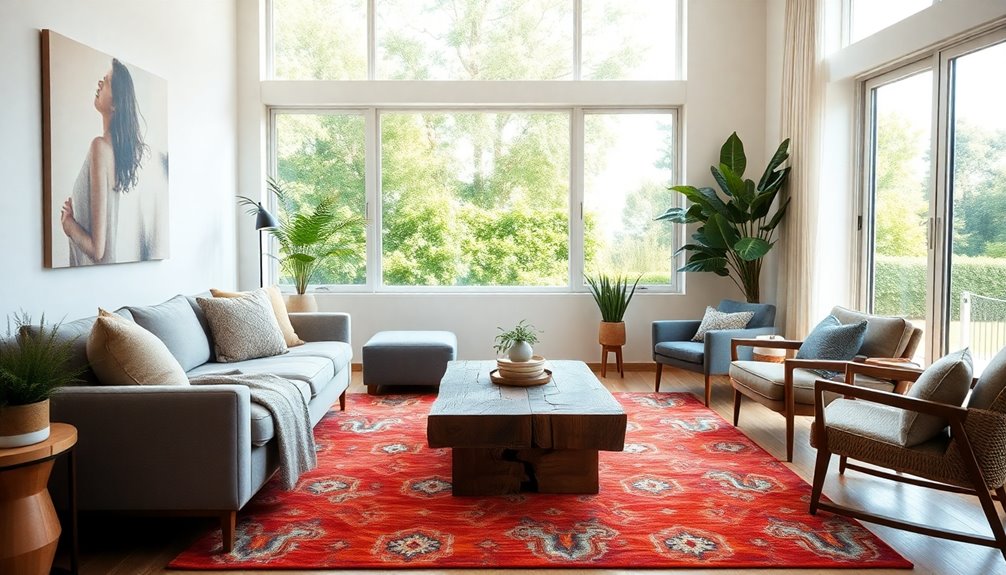
Lighting sets the mood for any space, but the right furniture can enhance both functionality and aesthetics. Start by defining your design principles: balance, unity, and variety are crucial for stability and interest. Consider the importance of scale and proportion to ensure that your furniture complements the overall space and does not overwhelm it. Additionally, integrating smart home devices can enhance the functionality of your space, making it more versatile and user-friendly.
Use empirical knowledge and intuition to guide your choices, ensuring your designs are both functional and appealing. Think about accessibility, keeping user needs at the forefront, and comply with safety standards. Sustainability is key; opt for eco-friendly materials. Don't forget the phases of design: gather information, research your space, and refine your ideas based on feedback.
Textiles and Patterns Overview

Textiles and patterns play a crucial role in transforming your space, bringing it to life with texture and visual interest. You can choose from a variety of fabric types, like geometric patterns for a calming effect, or floral designs that exude freshness. Quality textiles contribute to the overall value of a home, making your investment in high-quality materials worthwhile. Choosing durable materials can further enhance the longevity of your textiles.
Checked and tartan patterns offer timeless appeal, while abstract styles add a modern twist. Use these fabrics in curtains, upholstery, or carpets to enhance comfort and style in your home. Striped patterns can make small spaces feel larger, and intricate designs can serve as stunning wall decor. By thoughtfully selecting textiles and patterns, you'll create a space that reflects your personality and feels inviting.
Embrace the variety to craft a unique atmosphere you'll love.
Incorporating Decorative Elements
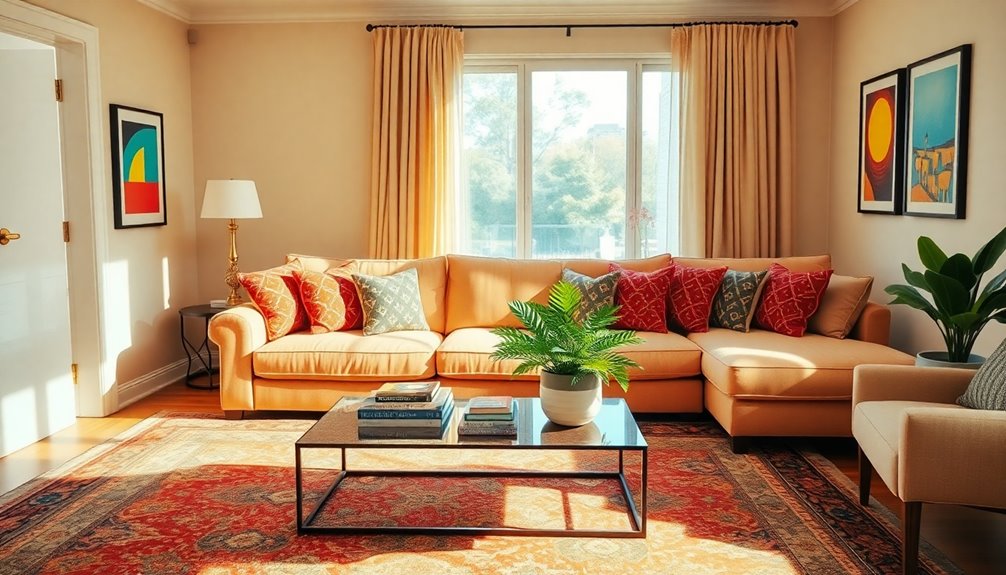
While your choice of textiles and patterns sets the foundation, incorporating decorative elements truly personalizes your space.
Start with artwork and prints that resonate with your style, like abstract pieces or cherished photographs. Mirrors can enhance light and create an illusion of space, while decorative lighting fixtures, such as chandeliers or sconces, elevate the ambiance.
Don't forget about ornaments and figurines; they add visual interest and character. Use a cohesive color scheme to tie everything together, ensuring balance and harmony.
Layer different textures and materials—think wood, metal, and glass—to create depth. Incorporating sustainable materials can further enhance the aesthetic while being environmentally conscious.
Lastly, maintain flexibility with modular furniture and easy-to-move items, allowing your decor to evolve with your tastes and seasons.
Embracing Technology in Design

As you venture into designing your space, embracing technology can transform both functionality and aesthetic appeal. Integrating smart home automation, like voice assistants and smart lighting, allows you to control your environment effortlessly. These systems adapt to your lifestyle, enhancing comfort and convenience.
Consider digital decor, such as high-resolution art displays and smart mirrors, to add a modern touch. They not only beautify your space but also provide information at a glance.
Sustainable design is another essential aspect. Energy-efficient appliances, green materials, and water conservation systems contribute to a healthier planet. Additionally, the incorporation of heat pumps and indoor air quality can significantly improve the comfort and health of your indoor environment.
Finally, utilize virtual and augmented reality tools to visualize your design choices before making them. This tech-savvy approach ensures your space is both stylish and functional.
Frequently Asked Questions
How Do I Choose a Theme for My Space Design?
To choose a theme for your space design, start by identifying your personal preferences in style and color scheme.
Consider your lifestyle and needs—if you work from home, select a theme that boosts productivity.
Incorporate personal elements like memorabilia and nature to make it uniquely yours.
Seek inspiration from design blogs or social media, and don't hesitate to consult an interior designer for expert advice.
This process will help create a space you truly love.
What Are the Best Materials for Eco-Friendly Furniture?
When it comes to eco-friendly furniture, think of it as a dance between nature and design.
You'll want to choose sustainable wood like reclaimed or FSC-certified varieties. For fabrics, opt for organic cotton or hemp, which tread lightly on the earth.
Non-toxic materials like natural latex and recycled metals are also great picks. By selecting these materials, you're not just furnishing your space; you're making a positive impact on the planet.
How Can I Incorporate Personal Style Into My Design?
To incorporate your personal style into design, start by defining your aesthetic preferences and gathering inspiration.
Identify key elements like colors and textures that resonate with you, while considering your lifestyle needs.
Choose statement furniture and functional decor that reflect your tastes.
Don't forget to add personal touches, such as family heirlooms or meaningful artwork.
Mixing different styles can create an eclectic yet cohesive look that truly feels like home.
What Are Some Common Design Mistakes to Avoid?
Imagine walking into a room that feels chaotic and uncomfortable; it's a feeling you can easily avoid.
To steer clear of common design mistakes, make sure you plan your space thoughtfully, measure accurately, and maintain a cohesive style.
Don't overlook lighting—both natural and artificial matters.
Choose colors wisely, balancing bold and neutral shades, and prioritize storage to keep clutter at bay.
How Often Should I Update My Decor?
You should update your decor regularly to keep your space feeling fresh and aligned with your life.
Seasonal updates can bring vibrancy, while themed decor adds excitement during holidays or special occasions.
Pay attention to lifestyle changes—moving, getting married, or having kids often calls for a decor refresh.
Finally, as your personal style evolves, don't hesitate to swap out colors, furniture, or accessories to reflect who you're today.
Conclusion
As you step back and admire your beautifully designed space, picture the warm glow of soft lighting casting gentle shadows on your carefully chosen colors. Imagine sinking into your cozy furniture, wrapped in the inviting textures of rich fabrics and playful patterns. With every personal touch, from vibrant artwork to sleek tech, your space transforms into a haven that reflects your unique style. You've crafted a sanctuary where every corner invites you to relax and savor life's moments.


